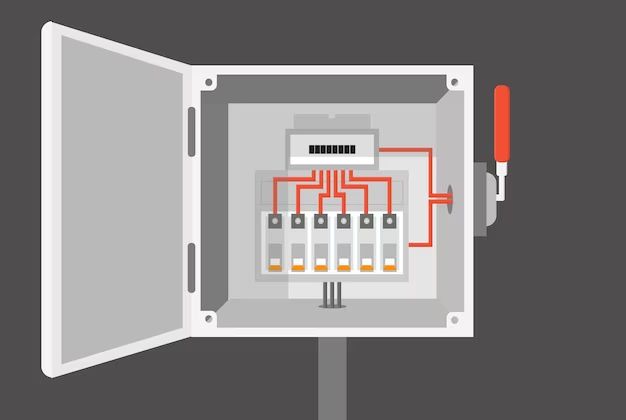Whether it is acceptable to cover an electrical panel or breaker box is a common question for many homeowners. The short answer is no, it is generally not advisable or legal to fully cover a breaker box according to electrical codes. However, there are some exceptions where partial covering or screening may be allowed if done correctly.
Page Contents
Why You Should Not Cover a Breaker Box
There are a few key reasons why you should avoid fully covering or enclosing a breaker box:
- Access – Electricians and homeowners need to be able to easily access the breaker box to reset tripped breakers. Covering the breaker box could make it hard to quickly cut power in an emergency.
- Ventilation – Breaker boxes generate heat and need to be properly ventilated to avoid overheating. Covering them can block air flow and lead to dangerous overheating.
- Fire hazard – Enclosing the electrical panel in combustible materials introduces a fire risk if a short circuit were to occur.
- Against code – Most building codes and electrical codes prohibit concealing or obstructing the breaker box.
When Partial Covering is Allowed
In some cases, it may be permissible to partially cover or screen a breaker box if done safely. Here are some examples:
- Locate the box in a closet or utility room where one side is left uncovered for access.
- Build an access panel or door to screen the box while still allowing the front cover to open.
- Use non-combustible screening materials like metal mesh or cement board.
- Leave at least 30 inches of clearance in front of the box.
- Check your local electrical code for exact requirements.
Materials to Avoid
These types of combustible materials should never be used to enclose a breaker box:
- Drywall
- Plywood
- Plastic
- Fiberboard
- Flammable insulation
- Wallpaper
The heat and potential arc flash hazard make these unsafe choices. Only use fire-resistant materials if you plan to screen or partially cover the box.
Conclusion
Covering up a breaker box is generally prohibited by electrical codes due to serious safety hazards, especially the risk of fire from arc faults or overheating. Homeowners should avoid enclosing a breaker box fully behind walls or other materials. If necessary, only partial screening or covering with fireproof materials may be acceptable if access and ventilation are still adequate. Always check with your local building department before concealing any part of an electrical panel. Keeping your breaker box easily accessible at all times is the safest approach.
Frequently Asked Questions
Is it illegal to cover an electrical panel?
Yes, in most cases it is against building and electrical codes to conceal a breaker box behind walls, insulation, or other materials. The National Electrical Code requires at least 30 inches of clear space in front of the panel cover.
Can you put a false wall in front of a breaker box?
Generally no, you should not construct a false wall that fully blocks access to the breaker box. However, you may be able to install a partial wall or screening in front of it if the panel cover can still be fully opened.
Can you drywall around a breaker box?
No, drywall should not be installed directly around or in contact with a breaker box, as drywall is a combustible material. The area 30 inches in front of the panel should remain open.
Is it OK to cover a breaker box with plywood?
No, plywood should not be mounted directly over a breaker box. The fire risk is too high if the plywood were to ignite from an electrical fault. You should only use non-combustible screening materials.
Can you put wallpaper over a breaker box?
No, wallpaper should never be applied over a breaker box, even with a cover over it. Wallpaper is considered a combustible material and could ignite if a fire occurred.
Important Notes
- Always consult your local building codes for legal requirements on screening breaker boxes.
- An electrical permit and inspection may be required for any work on or around the electrical panel.
- Hire a qualified electrician if you have any doubts about working safely around your breaker box.
- Keep flammable materials like drapes or furniture away from the breaker box area.
- Make sure any screening materials are securely fastened and will not obstruct access.
- Label the screening access panel or door to indicate the location of the breaker box.
Summary Table
| Allowed by Code? | Material |
|---|---|
| No | Drywall |
| No | Plywood |
| No | Plastic |
| No | Fiberboard |
| No | Flammable Insulation |
| No | Wallpaper |
| Yes | Metal Mesh Screen |
| Yes | Cement Board |
This summarizes which materials are permitted or prohibited to be used around a breaker box for screening or covering according to code.
Closing Recommendations
- Always keep your breaker box easily accessible – safety first.
- Consult an electrician if you have any questions.
- Check your local building codes for requirements.
- Use only fireproof screening materials if necessary.
- Maintain ventilation and clearance in front of the breaker box.
- Never fully enclose a breaker box behind combustible materials.
Following these electrical safety guidelines will help ensure your breaker box remains accessible and hazard-free. Take care when considering any modifications around your home’s important electrical panel.
